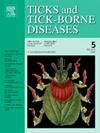野生动物保护区内蓖麻蜱、麻血蜱和残血蜱的同域分布
IF 3.4
2区 医学
Q2 INFECTIOUS DISEASES
引用次数: 0
摘要
野生动物保护区是一种非本地动物物种高度集中的封闭生态系统。r本文章由计算机程序翻译,如有差异,请以英文原文为准。
Sympatric occurrence of Ixodes ricinus, Haemaphysalis concinna and Haemaphysalis inermis in a wild fauna reserve
Wildlife reserves represent confined ecosystems with a high concentration of non-native animal species. The Réserve Zoologique de la Haute Touche, a unique forested environment, houses approximately 50 species, primarily Artiodactyla and Perissodactyla. We conducted a comprehensive tick survey within the reserve in 2017, collecting ticks from vegetation by flagging (outside enclosures on 101 sampling points in May and September, inside 21 enclosures in May), by visual search outside enclosures in May, and directly on animals captured for routine veterinary interventions, over four consecutive years (2015–2018).
A total of 13,038 questing ticks, representing seven species, were collected via flagging outside and inside enclosures. Ixodes ricinus (88.9%), Haemaphysalis concinna (10.1 %), and Haemaphysalis inermis (1 %) were the dominant species, with all three parasitic life stages of these species found in May. The less common species were Ixodes acuminatus (2 nymphs), Ixodes frontalis (2 nymphs), Dermacentor reticulatus (3 adults), and Dermacentor marginatus (1 adult). Ixodes ricinus was ubiquitous throughout the reserve, outside and inside enclosures, at nearly all sampling sites (100/101 and 9/21 enclosures), followed by H. concinna (78/101 sites and 6/21 enclosures) and H. inermis (49/101 sites and 1/21 enclosures). Tick densities varied greatly with peak densities reaching 1221 I. ricinus nymphs per 100 m² and 46 I. ricinus adults per 100 m² in May. Haemaphysalis concinna densities reached 124 nymphs per 100 m². Visual searches for adult ticks on vegetation revealed statistically different proportions of these three species between different areas of the reserve, with H. inermis reaching 40.5 % of the collected adults in a specific area. Enclosures housing roe deer (Capreolus capreolus) and red deer (Cervus elaphus) exhibited the highest tick abundance on vegetation. Feeding ticks, including I. ricinus (n = 53), H. concinna (n = 26), and D. reticulatus (n = 1), were collected from 15 animals of six ruminant species.
This study represents the first documented sympatric occurrence of I. ricinus, H. concinna, and H. inermis in France, and the first description of Haemaphysalis species within a zoological reserve. The potential for pathogen transmission by these three generalist species and especially Haemaphysalis species (paucity of data) warrants further investigation.
求助全文
通过发布文献求助,成功后即可免费获取论文全文。
去求助
来源期刊

Ticks and Tick-borne Diseases
INFECTIOUS DISEASES-MICROBIOLOGY
CiteScore
6.90
自引率
12.50%
发文量
185
审稿时长
6-12 weeks
期刊介绍:
Ticks and Tick-borne Diseases is an international, peer-reviewed scientific journal. It publishes original research papers, short communications, state-of-the-art mini-reviews, letters to the editor, clinical-case studies, announcements of pertinent international meetings, and editorials.
The journal covers a broad spectrum and brings together various disciplines, for example, zoology, microbiology, molecular biology, genetics, mathematical modelling, veterinary and human medicine. Multidisciplinary approaches and the use of conventional and novel methods/methodologies (in the field and in the laboratory) are crucial for deeper understanding of the natural processes and human behaviour/activities that result in human or animal diseases and in economic effects of ticks and tick-borne pathogens. Such understanding is essential for management of tick populations and tick-borne diseases in an effective and environmentally acceptable manner.
 求助内容:
求助内容: 应助结果提醒方式:
应助结果提醒方式:


